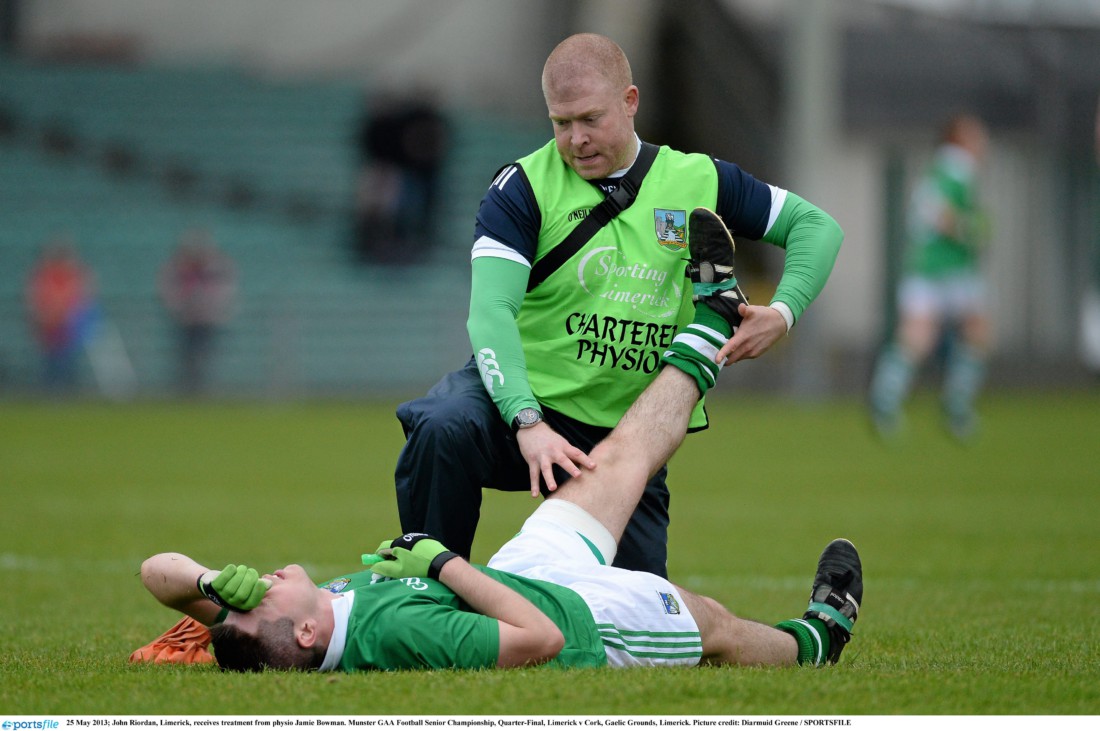HAVE you ever been running along in training or a match and felt a ping at the back of your thigh?
Unfortunately, this is the symptom of a hamstring strain, the most commonly experienced injury in Gaelic sport.
We will discuss who is at risk of hamstring strains and the top five hamstring exercises to recover from them.
They are also effective exercises to prevent hamstring injuries.
WHO’S AT RISK?
The research into hamstring strains indicates many factors expose a player to injury. They include:
Previous hamstring injury – this is an obvious factor but the reason is that players return to sport before they have fully regained their hamstring strength.
Age – naturally as we age, our muscle fibres reduce in size and we lose muscle mass and strength.
Lack of hamstring flexibility – during sprinting or kicking, our hamstrings stretch out and a lack of flexibility can cause the muscle to strain.
Back of hamstring strength – during sprinting, the hamstring muscle produces two different forces or muscles contractions. The muscle eccentrically contracts as the leg is being stretched out in front. This slows the movement of the leg just before the foot hits the ground. Secondly, when the foot is on the ground, the muscles concentrically contract to push the leg backwards, thus driving the body forwards.
TOP FIVE HAMSTRING EXERCISES
Exercises should focus on both hamstring flexibility and strength. It would be counterproductive to work on one aspect without the other.
Here are my five top hamstring exercises to keep you off the sidelines:
Nordic Hamstring Curl
This exercise has been proven to reduce hamstring strains by 51 percent in footballers.
It is performed by kneeling on the ground with someone holding your ankles on the floor behind. Cross your arms over your chest and very slowly lower yourself. Once you lose control, put your hands out to catch yourself on the ground.
Top tip – you can do these on your own by wedging your heels under a weighted barbell.
Example programme: Week one: 3 reps x 2 sets, twice weekly. Week two: 5 reps x 2 sets, twice weekly. Week three: 5 reps x 3 sets, twice weekly. Week four: 8 reps x 3, twice weekly (maintain this throughout the season).
Single Leg Romanian Deadlift
This is one of my favourite hamstring exercises for two reasons.
Doing it on one leg means you force the muscle to do the work, improving any imbalances between each leg.
Secondly, the muscle is being stretched and strengthened at the same time. This movement replicates what the hamstrings do when you sprint or kick.
Hold a dumbbell or kettlebell with one hand. Stand on one leg with knee slightly bent. Now slowly lower the weight towards the ground, keeping your back straight and not allowing the knee to bend any further. The opposite leg should extend behind you at the same time. You will know you are doing this right if you feel a strong pull on your hamstring on the way down.
Eccentric Single Leg Slide
This is another single leg exercise that has been shown to maximise muscle strength.
It is best to do this on a wooden floor. Start by lying on your back and place a folded towel under one of your heels. Now lift your hips up into a bridging position. Lift the foot with no towel underneath, off the ground. Slowly slide the other foot forwards until the knee is straight. Use both feet to get back to the starting position.
Gymball Kicks
This exercise recruits muscles fibres at speed, an important part of rehabilitation to get back running.
Lying face down, get a partner to hold a gym ball against the gluteal muscles. Then quickly kick the gymball with alternate heels.
Start with three sets of 10 seconds, and gradually increase the time.
Core stability
The hamstrings muscles attach to the pelvis. It is important not to overlook pelvic stability when it comes to improving the hamstrings.
A study carried out by the University of Wisconsin Sports Medicine Department compared two hamstring rehabilitation programmes. The protocol that included core stability exercises resulted in a 7.7 percent hamstring re-injury rate within one year. The other group who did not do core stability exercises, experienced a hamstring re-injury rate of 70 percent within one year.
Examples of pelvic stability exercises include the front plank, side plank and side plank with a twist. There are many ways to progress these exercises over the season.
WHAT TO DO NOW
If you are a player or coach, think about introducing these hamstrings exercises into your off-season, pre-season and maintain this throughout the year.
Start by adding a core stability exercise into the pitch warm-up and include Nordic hamstring curls into your gym or pitch programme.
After all, hamstring strains are the most commonly experienced injury in Gaelic sport, often resulting in players missing weeks of training and matches.
ARE YOU FRUSTRATED WITH AN INJURY?
Jonny is a chartered Sports Physiotherapist and owns Physio Performance. He has helped get world-class athletes back on the pitch and performing at their best. Contact us for a complimentary phone consultation at www.physioperformance.co.uk to discuss the frustrations of your injury.
Receive quality journalism wherever you are, on any device. Keep up to date from the comfort of your own home with a digital subscription.
Any time | Any place | Anywhere












